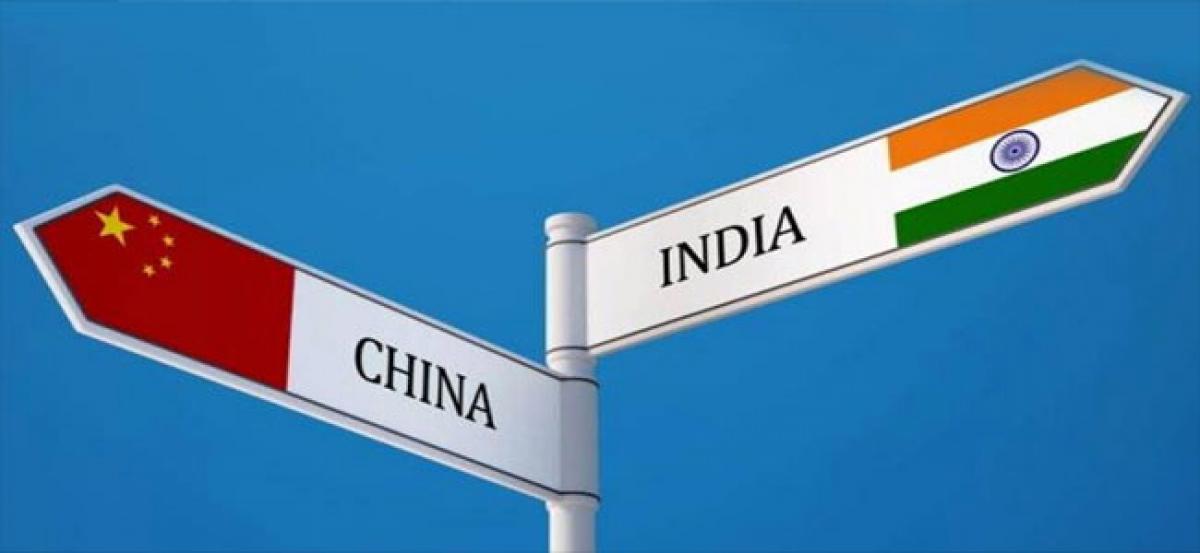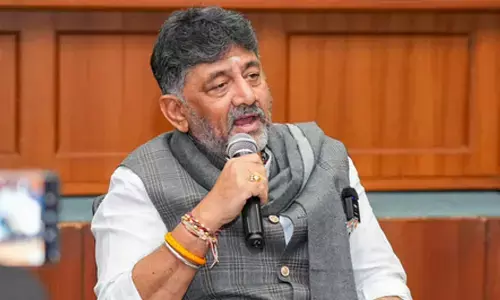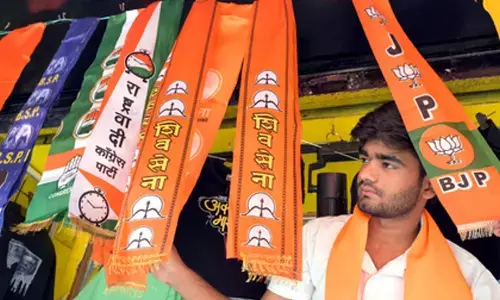Understanding the issue of India, China standoff at border

This time the matter is more contentious. To begin with, it is the first occasion that the Chinese have blocked access to the holy Mount Kailash through the Nathu-La route since it was opened in 2006 to facilitate both trade and pilgrimage.
China has ratcheted up pressure on India by officially publicising a military standoff at the Sikkim-Bhutan-Tibet tri-junction. Though the standoff between both the armies is quite common, events this time have raised concerns
This time the matter is more contentious. To begin with, it is the first occasion that the Chinese have blocked access to the holy Mount Kailash through the Nathu-La route since it was opened in 2006 to facilitate both trade and pilgrimage.
• China has accused Indian troops of “trespassing” its boundary and in a reaction suspended the pilgrimage to Mount Kailash in Tibet. The People’s Liberation Army has accused Indian troops of obstructing road construction on the Chinese side. China at Sikkim the issue led to the cancellation of the Mansarovar Yatra pilgrimage through the Nathu-la route.
• In June China removed an old bunker of the Indian army at the tri-junction of India, China and Bhutan in Sikkim. The Indian army had refused to remove the structure after being asked to do so by China. China, on its part, has alleged that Indian soldiers crossed the boundary into China to interfere with the construction of a road.
• At the heart of the border dispute between India and China is a road being built by China in Doklam, where it has a territorial dispute with Bhutan.
• Beijing has accused India of having a “hidden agenda” hinting that New Delhi is trying to stop it from building the road on Bhutan’s behalf. Bhutan has lodged a formal protest asking China to stop work on the road.
Past to present
• September 1967:
Chinese troops fired at Indian posts close to Nathu La and the Indian Army retaliated with full force causing casualties with China significantly higher. A ceasefire was declared later.
• June 1986:
The Indian Army launched exercise ”Chequerboard” after China amassed thousands of troops in the Thandrong pasture on the banks of the Somdurong Chu river. The situation was diffused diplomatically by August 1987.
• November 2008:
Chinese troops destroyed makeshift Indian Army bunkers at Doko La near the Sikkim-Bhutan-Tibet tri-junction.
• April 2013:
Chinese troops intruded into Daulat Beg Oldi in Eastern Ladakh and set up camps in the Depsang Valley. These came ahead of Premier Li Keqiang’s India visit.
• August 2014:
Chinese troops entered 25 to 30 km into the Indian territory in Burtse area in Ladakh and pitched their tents and the standoff continued for three weeks.
• September 2014:
About 1,000 troops intruded 3 km inside Chumar in Eastern Ladakh. The incident lasted for a week and coincided with Chinese President Xi Jinping’s visit to India.
• March 2016:
A platoon of chinese soldiers came about 5.5 km inside the Indian territory near Pangong Tso lake in Eastern Ladakh. Incident resolved in a few hours.
• June 2017:
China removed an old bunker of the Indian Army located at the tri-junction of India, China and Bhutan in Sikkim after the Indian side refused to accede to its request to dismantle it.
Know about the dispute:
• Indian troops have blocked a road under construction by China in a part of territory under dispute.
• Doklam, also called Donglang, is under Chinese control, but is also claimed by Bhutan. It is located at a tri-junction of India, Tibet and Bhutan and is close to the Nathu La pass, through which China has blocked this year’s Kailash Mansoravar yatra or pilgrimage over the border tension with India.
• Doklam is disputed territory and Bhutan has a written agreement with China that pending the final resolution of the boundary issue, peace and tranquility should be maintained in the area.
• The disputed area also provides, according to India perspective, a bigger buffer to its sensitive Chicken’s Neck, or the Siliguri Corridor, which is an extremely narrow stretch of land that connects the north-eastern region to the rest of India. From the Chumbi Valley it is just a little over 100 kilometres away.
• The standoff with China is in Bhutan’s territory and in a disputed area which is controlled by Thimphu but coveted by Beijing.
• The 89-square-km patch of territory in the Chumbi valley — sitting between Sikkim and Bhutan — is an unresolved boundary dispute Beijing has with Thimphu. The two countries have failed to resolve it despite 24 rounds of negotiations since 1984.
• The same plateau extends to the India-Bhutan-China tri-junction at the southern tip of Chumbi valley. The border with China is accepted by India along Sikkim, so there is no dispute between the two.
Importance of Doklam region:
The region holds immense strategic importance for India and China. Lying east of Sikkim, it has a commanding view of the Chumbi valley and overlooks the narrow Siliguri Corridor that links the North-East to the rest of India. If the Chinese gain control of Donglang, they gain the ability to essentially cut off India’s access to the North-eastern states in case of a conflict. In 1996, Beijing indicated it was ready to swap territorial claims in northern Bhutan in lieu of Donglang.
The Doklam Plateau, north of the tri-junction between Sikkim, Bhutan and Tibet by Indian claim, is not just a disputed area, but has huge strategic significance for both India and China.
• For Chinese to reach the China-Bhutan border posts, Doklam provides an easy way to construct their road, and they have been trying to do so and India has consistently objected to it. Not very far from Doklam is the strategically important Chumbi Valley in the Tibetan region, to which Chinese are now planning to expand their rail connectivity.
Infrastructure development
(India Vs China)
• Strategically located, Sikkim is a landlocked state with only one major road link – the National Highway-10. NH-10 cannot be operated and is closed for days due to landslides during monsoon.
• So, Sikkim suffers from disruption in supply of essential commodities when roads are blocked.
• To overcome the shortcomings and to enable military movement to the region in short times, a 52.7 km rail link between Sevoke in West Bengal and Rangpo in Sikkim is envisaged and was supposed to be ready by December 2015, but it got stuck in a procedural tangle.
• As Sikkim shares its border with China, the project has strategic importance, too. The proposed rail lines will facilitate movement of both men and material to the border areas at a short notice and with ease.
• The main issue of contention for the project is the use of 86 hectares of forest land, which needs clearance from the environment ministry.
• Also, under the Forest Rights Act 2006, the project needs to be cleared by the local gram Sabhas. But, the Kurseong and Kalimpong divisions of the Darjeeling Gorkha Hill Council do not have panchayats. The rail line tracks will pass through Mahananda sanctuary and forest divisions of Kurseong, Darjeeling, Kalimpong and East Sikkim which are known for their rich wildlife diversity.
• It is also contested that wild elephants and other protected animals are mowed down by trains along another broad gauge line inside the sanctuary.
• The Supreme Court has very recently given nod to the railway line from Sevoke in West Bengal to Rangpo in Sikkim. The New Rail Line Project is a 44.98 km with only 7.6% of the tracks falling in Sikkim and it is likely to accelerate socio-economic development of the people in the region once built.
• The court also instructed the railways to strictly adhere to environmental safeguards fixed by the national wildlife board, which approved the project in June 2015.
Nathula pass
• After the 1962 border war with China, Nathu La and Jelep La, the two main passes, which connect Sikkim with Tibet, were closed for trade.
• Lhasa, which is the capital of Tibet is barely 425 km from Nathu La. In June 2006, the Nathu La Pass, a century-old trading post, which is 4,545 meters above sea level was reopened after being closed for 40 years.
• After Vajpayee’s visit to China in 2003, both countries agreed to resume trade through Nathu La pass and signed the declaration of principles for relations and comprehensive cooperation including the memorandum on expanding border trade that provided for the formal reopening of Nathu La as a border trade pass between Indian and China.
• In 2003, China invested about 200 billion RMB (USD24.3 billion) in infrastructure projects in the western region. China has further unveiled its plans to extend the Chinese National Rail Network to the border with India. Nathu La will help China in connecting to Kolkata, the closet warm water port to Lhasa.
• It is envisaged that a fully equipped route across Nathu La has the prospect to change the trade in this sector of Asia as the distance from Kolkata to Lhasa through this route is less than 1200 km.
• Trade through Nathu La is in the interest of people from both sides of the border and would bring economic prosperity. However, the flip side of the problem is small traders may face competition from the Chinese market competition and the market in the region would be flooded with cheap Chinese goods and would make the indigenous market less competitive.
• The benefit of opening Nathu La is not only for economic prosperity. The strategic and political dimensions must also be considered.
Border disputes between India and China:
India and China share about 3,488-km long border, which is yet to be fully delineated. The border is classified under 14 divisions. There is a Line of Actual Control in Aksai Chin of Ladakh region that China captured during 1962 war.
• Till 2003, China claimed Sikkim was an independent country whose monarch had in the past accepted Beijing’s suzerainty. This make-believe assertion was finally dropped by China during then Prime Minister Atal Bihari Vajpayee’s visit to Beijing in 2003.
It was also agreed during that visit that the two countries would progress rapidly to formally delineate unmarked portions of the Line of Actual Control as the first step towards settling the long-standing border dispute.
• India and China appointed two Special Representatives to take the negotiations forward. Informally, the two countries agreed to demarcate a permanent border “without unsettling settled populations”. Shorn of diplomatic verbiage, this was interpreted to mean China giving up its claim on 90,000 sq.
kms of Arunachal Pradesh, particularly the district of Tawang (which was well-populated), in exchange for India officially recognizing China’s occupation of the unpopulated cold desert of Akasi Chin, most of which has been under Chine occupation.
•This still left the issue of the slice of Indian territory seized by Pakistan and subsequently “gifted” or ceded to China by Islamabad. It is through this piece of mountainous terrain that the controversial China-Pakistan Economic Corridor is being built to give China access to the warm waters of the Arabian Sea through the Gwadar port.
Bhutan faults China
• Lu repeated China’s assertion that Donglang – which he called Doklam – was part of Chinese territory “since ancient times and it doesn’t belong to Bhutan”.
• He accused India of impinging on Bhutan’s sovereignty by attempting to fight its battles. “We hope that all countries can respect Bhutan’s sovereignty.
• Although the boundary between China and Bhutan is yet to be demarcated, the two sides have been working on that through peaceful negotiation. Any third party must not and does not have the right to interfere, still less make irresponsible moves or remarks that violate the fact,” he said.
• Currently, Bhutan does not have diplomatic relations with China, but maintains contacts with periodic visits by the Chinese ambassador based in Delhi.
• Meanwhile, Bhutan’s ambassador to India, Major-General V Namgyal told that “the road construction by the Chinese Army was ‘progressing toward’ a camp of the Royal Bhutan Army at Zom Pelri” and that his government had told the Chinese side that this construction “is not in keeping with the agreements between China and Bhutan [on resolution of their boundary],” Ambassador Namgyal was quoted as saying. He added that Bhutan has asked China to “stop and refrain from changing the status quo.”
China’s Stance
• China’s assertion that Donglang which he called Doklam was part of Chinese territory since ancient times and it doesn’t belong to Bhutan.
• China’s boundary with India at Sikkim was based on a 127-year-old treaty signed between the Qing empire and Great Britain – the Anglo-Chinese Convention of 1890.
• Accused India of impinging on Bhutan’s sovereignty by attempting to fight its battles.
• The suspension of the pilgrimage route was an emergency response to the situation. The pilgrimage route will reopen, it totally depends on whether the Indian side can correct its mistake in time.
Intentions behind China’s aggressive moves:
• Beijing has always aspired to be the Asian hegemon. It is intensely distrustful of its two economically powerful neighbours – Japan across the sea and India across the mountains.
• India, however, is a huge market for Chinese consumer goods. And that is an opportunity Beijing does not want to forgo. But India’s growing economic and diplomatic clout ruffles China. The evident camaraderie between two tough-talking leaders, President Trump and Prime Minister Modi disturbs China’s long-term goals.
• India’s unflinching opposition to China’s grandiose One Belt One Road (OBOR) idea marks a setback for Beijing’s strategic economic and political pursuits.
• Clearly, China wants to keep India engaged in territorial issues with it and its ally Pakistan. Since it has surged way ahead of India in terms of economic development, China wants to zealously guard the advantage, pricking India from time to time to register its military superiority.
• In Beijing’s view, India is a critical ‘swing State’ that increasingly is moving to the US camp, undercutting Xi’s ambition to establish a Sino-centric Asia through an expanded tianxia system of the 15th century.
• Given India’s vantage geographical location, China needs its participation to plug key gaps in Xi’s One Belt, One Road (OBOR) project. But India not only boycotted Xi’s OBOR summit but has also portrayed OBOR as an opaque, neo-colonial enterprise seeking to ensnare smaller, cash-strapped states in a debt trap.
Why should India be worried?
China is already stepping up its direct and surrogate threats against India. One example is the proliferation of incursions and other border incidents since the 2005 India-US nuclear deal, which laid out a strategic framework for the US to co-opt India. China is also waging a spy-war through media.
With Chinese forces aggressively seeking to nibble away at Indian Territory, India’s Himalayan challenge has been compounded by a lack of an integrated approach that blends military, economic and diplomatic elements into a coherent strategy.
Concerns
• Chinese infrastructure has been increasingly developed and better in the region for some time now.
• India, on the other hand has been indifferent demonstrating little sense of urgency on the issue.
• The roads in Gangtok are not all-weather roads and are incapable of carrying a high volume of trade.
• On the Tibet side, China has built up a four-lane all-weather roads connecting Lhasa with Gangtok.
• By paying emphasis on the western region, the Chinese government is trying to prevent any restlessness and tighten its grip on Tibet.
• It is contested that China may try to influence Sikkim and bring unrest in the otherwise peaceful state.
• India has to revise its frontier policy and should devise policies, which will be pragmatic and proactive. Bureaucratic and procedural hurdles have to be curtailed in order to improve our strategic assets in this strategic State.
Way ahead:
While the latest hostile action on the Nathu La Pass and the verbal conflagration that followed may not escalate into something bigger, India needs to clearly size up China’s Big Power aspirations.
Arguably, India has to both compete and, in many cases, cooperate with China and cannot afford permanent hostility. But there is an in-built economic conflict between the two countries that is bound to spill over into active hostility, spurred mainly by China.
Beijing prides itself for settling border disputes with all its neighbours except India. But these settlements have mostly been among unequals (barring Russia).
India’s status in the world today nettles China but New Delhi too needs to tread cautiously without escalating tensions. Despite the cosy ties with Washington, India, essentially, is on its own against China. It needs to bolster its border defences and boost it’s nuclear and missile deterrent capabilities.
Conclusion:
India and China are the two ancient civilizations, who have had centuries of cultural exchanges but in modern times, their relationship has been more adversarial than friendly. As big economic and military powers, India and China are key strategic players in the world. Both nations have several similar attributes and problems including large population, huge rural-urban, rising economy and conflict with neighbours.
Disruption of the Kailash-Mansarovar Yatra may seem humiliating, but if China insists on flexing its muscles in this manner, we may need to ignore it for the present and await a suitable opportunity to demonstrate our growing clout in the world. But for that, India’s economic growth must catch up with China at least in the medium term. Resolving the border issue cannot be our priority till then.
By Gudipati Rajendera Kumar














